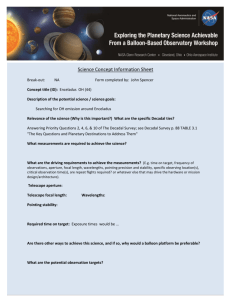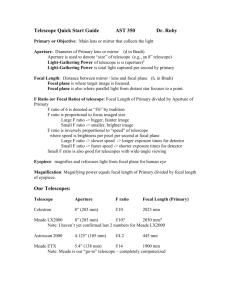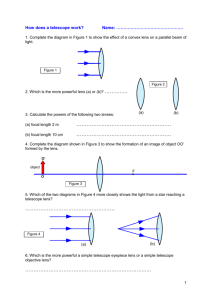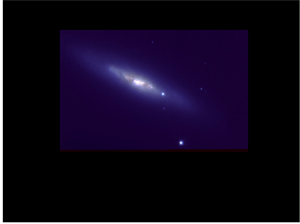Telescope Types
advertisement
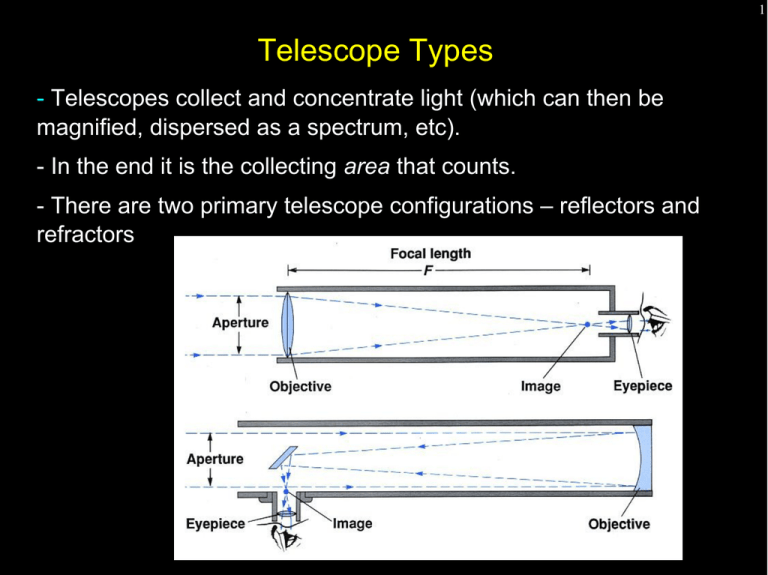
1 Telescope Types - Telescopes collect and concentrate light (which can then be magnified, dispersed as a spectrum, etc). - In the end it is the collecting area that counts. - There are two primary telescope configurations – reflectors and refractors 2 Reflectors vs. Refractors Refractors can be great backyard telescopes, but all large modern research telescopes are reflectors. A mirror can be supported from behind and does not need to be transparent or perfect on the inside. 3 Telescope Precision A giant telescope mirror must be manufactured with a surface precision of 1/1000th the width of a human hair (less than 1/10 of a wavelength). The mirror support structure must hold this precise shape as the telescope points around the sky. 4 Historic Monolithic Mirrors ● In the old days, mirrors had to be thick so that they could be stiff enough to avoid distortion. Thick = weight = bad. 5 Historic Monolithic Mirrors ● In the old days, mirrors had to be thick so that they could be stiff enough to avoid distortion. Thick = weight = bad. 6 Modern Mirror Support (LBT) ● Computer control enables the use of thin, floppy mirrors. 7 Modern Mirror Support (LBT) ● Today mirrors can be thin with shape maintained by computer control. 8 Telescope Geometry The overall goal is to create an image of the sky on an, ideally, flat “focal plane” Start with a simple pinhole camera – in the end image sizes scale in the same way. 9 Telescope Geometry Lenses collect light over a larger area, but the central ray is undeviated so the pinhole camera concept is still informative. 10 Focal Length and f-number The focal length of a lens is the distance from the lens (actually from its principal plane) to the lens' focus when imaging a point source at infinite distance (parallel incident rays). The “f-number” of a lens is the ratio of its focal length to its diameter 11 Plate scale An arcsecond of angle on the sky maps to some linear dimension at the focal plane of a lens. The “plate scale” is a number connecting the astronomical angular scale to the physical scale of the detector (in the old days photographic plates – thus the name). Via the small angle equation, given the focal length F... mm / arcsec=F ( mm ) / 206265 206265 ( mm ) arcsec/ mm= F Since lenses are often described by their “focal ratio”, f, which is their focal length divided by their diameter, D, so F=fD.... 206265 arcsec/ mm= fD 12 Plate scale These equations derive from knowing that rays through the middle of a lens are undeviated. Consider an object subtending an angle of one arcsecond. F one arcsecond x Lens θarcsec x = 206265∗ F You can either set theta to 1 arcsec and solve for x – giving you millimeters per arcsecond (assuming you express F in millimeters). Or set x=1mm and derive the number of arcseconds per millimeter. mm / arcsec=F ( mm ) / 206265 206265 ( mm ) arcsec/ mm= F 13 How a Telescope Works An “objective” optic (lens or mirror) forms an image. The observer inspects the image formed with a small magnifying glass (the eyepiece). eyepiece objective F objective Magnification = F eyepiece 14 Geometrical vs. Physical Optics A raytrace of a parabolic mirror will produce an infinitesimally small point image for an object on the axis of a parabola at infinite distance. In reality, the image size is limited by diffraction to an Airy pattern. http://library.thinkquest.org/22915/reflection.html 15 The Airy Pattern Diffraction blurs light passing through a clear circular aperture. The larger the aperture the smaller the angular blur. The size of the blur is wavelength dependent. Short wavelengths produce sharper images through the same aperture. λ FWHM = 1.03∗ D λ first null = 1.22∗ D 16 The Airy Pattern Diffraction blurs light passing through a clear circular aperture. The larger the aperture the smaller the angular blur. The size of the blur is wavelength dependent. Short wavelengths produce sharper images through the same aperture. λ FWHM = 1.03∗ D λ first null = 1.22∗ D 17 The Airy Pattern Diffraction blurs light passing through a clear circular aperture. The larger the aperture the smaller the blur. The size of the blur is wavelength dependent. Short wavelengths produce sharper images through the same aperture. λ FWHM = 1.03∗ D λ first null = 1.22∗ D 18 The Resolution/Rayleigh Criterion ● ● Two stars are considered to be “resolved” if they are sufficiently separated to fall beyond each other's first Airy nulls. Thus, formally, the resolution of a telescope is 1.22 λ/D. 19 Real “Point Spread Functions” Typically telescope apertures are not clean “circles” http://irsa.ipac.caltech.edu/data/SPITZER/docs/irac/iracinstrumenthandbook/images/IRAC_Instrum ent_Handbook091.png 20 Real “Point Spread Functions” Typically telescope apertures are not clean “circles” http://irsa.ipac.caltech.edu/data/SPITZER/docs/irac/iracinstrumenthandbook/images/IRAC_Instrum ent_Handbook091.png 21 Real “Point Spread Functions” Typically telescope apertures are not clean “circles” http://irsa.ipac.caltech.edu/data/SPITZER/docs/irac/iracinstrumenthandbook/images/IRAC_Instrum ent_Handbook091.png 22 Poisson Statistics ● Why is a sharp high-resolution image important? ● A small image minimizes the contaminating background and crams the most light into the minimum of detector pixels. ● ● Unwanted background = additional noise Detector pixels also contribute noise (readout noise). Fewer pixels per star image is better. 23 Poisson Statistics ● The uncertainty in a measurement in a counting experiment (detecting photons in this case) is equal to the square root of the number of counts. ● ● Quantization of light as photons makes astronomical detection a counting experiment Even with a perfect detection system with no noise and no interfering light from background, if you detect 100 photons from a star, the measurement is uncertain by 10 photons, or 10%. 24 Detecting Photons ● ● At wavelengths where photons are sufficiently energetic (hν > 1 eV) photons can interact with matter to create free electrons. A free electron is a countable electron! In the “photoelectric effect” photons with energy greater than the “work function” of the material can eject electrons into free space – easily counted. In “semiconductors” photons can elevate electrons from a bound “valence” band in to the “conduction” band producing a solid-state analog of the photoelectric effect. The band-gap in silicon corresponds to the energy of a 1.05um photon. 25 Poisson Statistics ● The uncertainty in a measurement in a counting experiment (detecting photons in this case) is equal to the square root of the number of counts. ● ● ● ● Quantization of light as photons makes astronomical detection a counting experiment Even with a perfect detection system with no noise and no interfering light from background, if you detect 100 photons from a star, the measurement is uncertain by 10 photons, or 10%. You can't measure a star to a precision of 1% until you have detected 10,000 photons from that star. Complicating this fact is that detection systems aren't perfect and there are contaminating sources of light such as the glow of the sky (and glow of the telescope in the thermal infrared) 26 Signal to Noise Ratio ● Traditionally, astronomers like to express the quality of the detection of a star or spectral line in terms of the ratio of signal to noise (signal-to-noise ratio or SNR). ● ● In simplest terms take the number of signal counts and divide by the uncertainty. S/N=10 is a measurement with 10% precision ● ● S/N=100 is a measurement with 1% precision ● ● 100 photons gets you there if there is no source of contaminating light. 10,000 photons without contamination. In general, if the star is the only source of counts. S N = = √( N ) N √( N ) 27 Accounting for Background Contamination ● ● Sources of background add to the detected photons. ● These unwanted counts add additional noise. ● Reducing these backgrounds improve signal-to-noise ● sharper images (landing on fewer pixels) ● selecting filter bandpasses to avoid skyglow ● cooling telescopes used in the thermal infrared If N is the number of counts from the star and B is the number of counts from the background. N SNR= √N +B ● Consider a star which covers 4 pixels, each containing contaminating background vs. one which covers 1 pixel. ● 4 times lower background in the second case.... Sharp images are good: Seeing, Diffraction, and Resolving Power A telescope's resolving power is limited by the worst of... - atmospheric “seeing” - the twinkling of the stars - diffraction - passing light through an aperture blurs the image. λ first null = 1.22∗ D 28 29 Resolving Power A telescope operating at radio wavelengths must have a huge aperture to achieve good resolution. diffraction - passing light through an aperture blurs the image. Working at long wavelengths (e.g. radio) requires a big telescope. Hubble produces sharper images with its ultraviolet cameras than with its infrared cameras. 30 Interferometry Multiple small telescopes can be combined to achieve the resolving power of a single giant mirror (but not the light collecting ability). 31 The Atacama Large Millimeter Array 32 The Atacama Large Millimeter Array http://www.christophmalin.com/files/BIGchile_cm_117.jpg.jpg 33 The Large Binocular Telescope 34 “Fixing” Atmospheric Seeing With fast computers and flexible mirrors astronomers can undo the blurring effects of the Earth's atmosphere. 35 “Fixing” Atmospheric Seeing With fast computers and flexible mirrors astronomers can undo the blurring effects of the Earth's atmosphere. 36 “Fixing” Atmospheric Seeing How fast? The critical time is the time it takes atmospheric “blobs” to blow across their diameter – typically 50 milliseconds. Correction has to happen about 10 times faster. These coherent atmospheric patches get effectively bigger as seen at longer wavelengths. Seeing becomes better – coherence times become longer. Today adaptive optics is impossible in the visible and feasible at near-infrared wavelengths. Space is still king shortward of 1um. 37 38 39 Optics, Ray Tracing, and Optical Design 40 Spherical Aberration An “on-axis” aberration which arises from different radial zones on a optic producing a focus at different distances. By its geometrical definition, a parabola is free of spherical aberration (but guilty of others). Coma Coma arises when incident rays are not parallel to the optical axis. • Like spherical aberration, coma is manifested by different radial zones in the optic • Each pair of symmetric points in each radial zone produces a sharp image, but since the lateral magnification is different for each pair each ring of incident rays forms an offset ring producing the classic “comma” image. 41 42 Chromatic Aberration The “lensmaker's equation” provides the focal length of a lens of a given refractive index, n. Since refractive materials have different refractive index at different wavelength, light comes to a focus in different places. 43 Controlling Chromatic Aberration Split the lens into two components (use additional surfaces to control classical aberrations). Make lenses out of materials with different dispersive properties Standard doublet Abbe formula Spherical (fig 6.3) 44 Cassegrain Telescopes as Compound Optics A cassegrain telescope is a two-optic system. • The primary forms a real image. • The secondary, which has a negative focal length, relays this real image to another real image in the focal plane. In a cassegrain configuration the secondary interrupts the converging beam from the primary before the real image forms, but the image is there for calculation's sake nonetheless. 45 Atmospheric Transmission ● The atmosphere blocks most of the electromagnetic spectrum. 46 Atmospheric Transmission ● The atmosphere blocks most of the electromagnetic spectrum. 47 Atmospheric Transmission ● The atmosphere blocks most of the electromagnetic spectrum.

